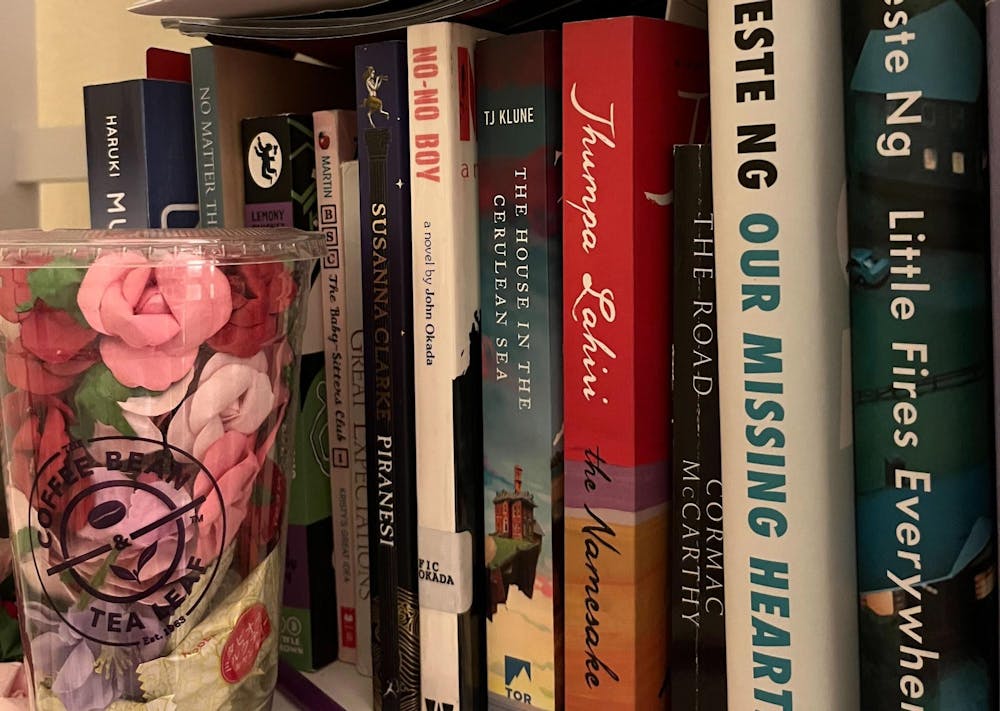Given the lack of diversity within the traditional literary canon (drinking game: take a shot for every famous author named “Jack” or “John”), it may come as a surprise that Amy Tan’s “The Joy Luck Club” is not the only Asian book on the literary scene. Having discovered this fact, I’ve made a conscious effort to read more books by authors of Asian descent, especially those dealing with “third culturism” — the reconciliation of an inherited culture with a different culture that one grew up or resides in. These are 10 of my favorite books by authors of Asian descent featuring Asian main characters, ranked from least to most focused on Asian identity.
“Yellowface” by R.F. Kuang
“Yellowface” begs the question of who is allowed to tell what stories. White narrator June Hayward rebrands herself as Juniper Song to publish her recently deceased, literary superstar friend’s unfinished manuscript about the Chinese Labor Corps. June is attacked for publishing under a racially ambiguous name and tries to fend off the rumors of plagiarism. Kuang uses these attacks and June’s defenses to meditate on cultural identity. How much more justified is Athena Liu, who grew up in a British upper-class family with private schooling and barely speaks Mandarin, to publish a book about Chinese culture over June Hayward? In our age of immigration and globalization, how much does inherited cultural identity, or lack thereof, really matter? Though Kuang doesn’t linger on these questions for quite long enough or with enough nuance, she has still crafted a fun novel that at least brings up such questions on identity.
“The School for Good Mothers” by Jessamine Chan
Chan’s novel features main character Frida Liu, who is forced into an institution with the feel of a boarding school in order to earn back custody of her child. The novel discusses the double standards expected of women versus men, especially regarding childcare, and it also talks about the intersection of gender and racial discrimination. Through her mandatory “racial sensitivity” training, Frida is forced to confront her own Chinese heritage. She also worries about the generational loss of culture as her daughter Harriet stays with Frida’s white husband and his white mistress. Chan’s dystopian world-building rivals that of Orwell and Bradbury, and her message on just how difficult it is to exist as a female, especially one of color, is stunningly impactful.
“Severance” by Ling Ma
Ma is one of my favorite authors solely because of how much I loved this book. “Severance” is set in a plague-ridden world eerily familiar to present-day readers, despite the book being published in 2018. We see the main character Candace’s perspective at various points in time: before the pandemic hits; during the pandemic as she refuses to stop working while struggling through a global and social deterioration; and in flashbacks about her childhood in China. Ma cleverly interweaves all these perspectives, resulting in an entertaining and incredibly intelligent satire that examines American capitalism and imperialism. I wanted to underline every single sentence in this book, and I would highly recommend it to anyone looking for a fun read.
“Everything I Never Told You” by Celeste Ng

“Everything I Never Told You” follows the struggles of Chinese-American character, James, his STEM-oriented wife Marilyn, and their three children as they carve their way through 1970s America. Ng’s characters are stunningly complex. Their conflicts, both internal and external, feel weighty and real, and Ng’s moving prose only heightens the emotional stakes. The book explores James’s difficulties with being a Chinese-American in academia, Marilyn’s adversities with her STEM aspirations, and how both of their traumas were generationally imparted onto their children. This is a prime example of a novel that discusses Asian identities in conversation with other minority identities. Not only does this create more complex characters and plotlines, but it is also more representative of people in the real world.
“A Scatter of Light” by Malinda Lo
“A Scatter of Light” is a wonderfully nuanced coming-of-age story about growing up at the intersection of many different identities. The main character learns — alongside the reader — how to exist as a queer woman of color pursuing both science and art. Readers should not be put off by the book’s categorization as Young Adult (YA). Though the language is distinctly YA, this serves as an advantage: The book is simple enough to read for fun, but Lo still provides enough depth in her characters and conflicts for readers who want more thought-provoking material.
“Days of Distraction” by Alexandra Chang

“Days of Distraction” is a slow, slice-of-life book following the Chinese-American narrator and her white significant other as she struggles through work and her relationship in Part I, then through a solo road trip in Part II. “Days of Distraction” stands out in its extensive discussion on relationships between white men and Asian women. Chang references numerous historic sources, contemporary books, and articles on race, providing a very unique touch that enhances the reading experience by allowing readers to explore the systems driving the main character’s internal conflicts, outside of the fictional setting. Though its slow pace is not for everyone, “Days of Distraction” is an enjoyable book for those with the time and patience to make their way through it.
“Babel” by R.F. Kuang
To anyone who has visited any vaguely commercial bookshop in 2022, the gray tower and spiraling white birds on the cover of R. F. Kuang’s “Babel” might be instantly recognizable. While the novel does fall prey to common pitfalls of Young Adult Fantasy — telling character development rather than showing it, with its prose verging on melodramatic — its other elements more than make up for it. The book’s main character Robin was taken from China as a child and has to grapple with his Chinese identity during his studies at Oxford University, certainly a predominantly white institution (PWI). Much of the book centers around the imperialism underlying all of Robin’s work, which seems fictional on the surface, but holds more historical truth than not. Kuang writes an entertaining book reminiscent of what made Harry Potter successful, but also integrates postcolonial and linguistic theory to satisfy readers who want more to think about.
“The Namesake” by Jhumpa Lahiri
Lahiri, who previously served as Princeton’s Program in Creative Writing director, crafts a generational story about the Ganguli family as the parents move to America and their son Gogol grows up. It is a complex, layered novel about living as an immigrant, beautifully representing the cultural and generational struggles that immigrants – both first and second generation – face. Lahiri’s characters and conflicts are all crafted masterfully, and you feel for the Gangulis, especially Gogol, as they struggle individually and collectively.
“No-No Boy” by John Okada
A criminally underrated novel, especially considering that it was a pioneer in Asian-American literature. Okada writes from the perspective of Ichiro, a “no-no boy” (the nickname given to Japanese-Americans who would not serve in the U.S. army or relinquish their Japanese identity) coming home after internment during World War II. The writing is brutally and emotionally raw in the most achingly gorgeous way. Okada himself was an internee, and it shows through the almost intimate language of the novel. Ichiro’s struggles as a no-no boy, both internal and external, feel very real and close as one reads the book, and it is truly an exceptionally written novel. Be forewarned, though, that this book is very much a product of its time, so there are instances of discrimination toward other minority groups, by both the main character and others. However, it is still an incredible book that everyone should read.
“Crying in H Mart” by Michelle Zauner
Michelle Zauner, also known as musician Japanese Breakfast, centers her memoir around growing up Korean American and her mother’s death, noting the grief that followed and her gradual reconnection to her Korean culture. “Crying in H Mart” saw huge commercial success after its 2021 release. Though it is largely the immigrant narrative of, among other things, being embarrassed over smelly lunch boxes, Zauner’s writing and story are compelling. The immigrant narrative and her struggles with her parents also make the book intensely relatable, meaning it also gets intensely emotional. It is a worthwhile read both for fans of Japanese Breakfast and those who have never heard of Zauner’s music. Readers will have a good experience regardless.
Audrey Zeng is a first-year contributing writer for the Prospect. She can be reached at audrey.zeng@princeton.edu.








